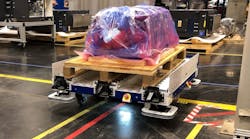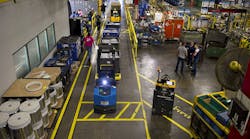Today, more and more companies in manufacturing and logistics use automatic guided vehicles (AGVs) and other robotic solutions to transport raw materials, components, and finished goods on the facility floor. According to Gartner, 75% of large enterprises will adopt some form of smart robots in their operations by 2026.
At the same time, there is increased competition for the types and different AGVs available in the market. As a result, selecting the right automated guided vehicle can be a daunting task for plant managers or logistics engineers who usually make these decisions.
To help with the decision-making process, we outlined all you must remember while choosing the right AGV system.
7 Tips for Choosing the Right AGV for Your Application
Before choosing what kind of driverless electric vehicle would be the best fit for your facility you have to learn how they work, which tasks you want to perform with AGVs, and more. Keep reading and find the right solution for your facility.
1. Get to Know the AGV Technology
AGVs are autonomous driverless vehicles that use a variety of guiding technologies to navigate the facility floor. The main AGV navigation systems include:
- magnetic navigation
- laser-guided navigation
- natural feature or free navigation
- inductive wire navigation
- magnetic spot navigation
- vision navigation
- optical navigation
Selecting the right navigation technology is essential because it influences your AGV’s system performance. Navigation systems are improving daily, achieving incredible performance levels, and redefining many facilities.
In addition, the type of navigation system also significantly affects the AGV’s applications and cost. Outstanding developments have made AGVs and autonomous mobile robots (AMRs) more reliable, accurate, and cost-effective, thanks to ultrasonic sensors, magnetic sensors, cameras, and 2D or 3D LiDAR.
Skilled automation integrators can solve the most challenging automation tasks that require complex system designs and extensive engineering knowledge. The right AGV navigation technology should meet the needs of your facility.
2. Think About the Tasks That You Want To Perform With AGV
You must consider the tasks you wish your AGV to handle before selecting the right one for your facility. Different AGVs and navigation technologies are best suited for their unique applications.
The four main types of AGVs have different applications in various industries:
- automated guided carts
- towing AGVs
- automated forklifts
- and unit load AGVs
Automated Guided Carts
Automated guided carts (AGCs) have a low-profile small chassis that engages carts, shelves, and trolleys from beneath. Their navigation technology can range from complex sensor-based systems that depend on artificial intelligence to simple magnetic tapes.
AGCs are low-cost, easy to install, flexible, and significantly improve safety, making them suitable for automating non-value-adding tasks. Using them eliminates the need for workers to push carts and trolleys.
Towing AGVs
Towing AGVs also referred to as tugger vehicles, are built for towing multiple carts and have greater throughput than AGCs. They can pull loads of tons at a low cost, reducing the risks of using heavy and large equipment.
Heavy-towing AGVs can pull bulk materials, machine components, sub-assemblies, and equipment that would be risky for manual labor. They have numerous applications in the manufacturing and automotive industries.
Automated Forklifts
Automated forklifts can retrieve stock, place materials, and stack pallets. They are ideal for supplying materials to computerized machines and moving finished goods from the production line to storage or for shipment.
Automated forklifts are economical because they replace forklift operators who require training and certification. They are ideal for manufacturing facilities and warehouses.
Unit Load AGVs
Unit load AGVs handle individual items or a single load, such as a pallet or tote with multiple items. They navigate fast and safely in warehouses and production facilities. A unit load handler is ideal for delivering packages that may be hazardous or heavy for manual labor.
3. Calculate Your ROI
Calculating your return on investment (ROI) is vital in deciding whether to buy an AGV and which one to buy. It requires an assessment of the current processes, understanding your investment, and estimating the expected gains.
The decision to install an AGV system relies on its ability to offer ROI in a reasonable time. Cost-effective, more flexible, and capable robotic solutions are accelerating the growth of facilities.
As a result, more facilities are moving towards automation. In the Netherlands, a Phillips industrial plant that produces electric razors has more robots than human workers, with the robots outnumbering humans in a ratio of 14 to one. Similarly, a Fanuc plant in Japan uses industrial robots supervised by a team of four workers.
Automation can Generate Savings of 40 to 75% in Labor Hours
As robotic solutions increase, the costs have gone down. Besides freeing humans from dangerous, dull, and dangerous jobs - manufacturing facilities cut their operational costs by replacing humans with much more cost-effective and efficient machines.
According to a recent Office Worker Survey, 68 percent of US workers believe that robotic process automation (RPA) increases productivity and saves time. These are critical aspects in measuring the ROI of an automated system. In addition, RPA can generate savings of 40 to 75% in labor hours in MedTech companies.
4. Measure Organizational Readiness Before Deploying AGV
Organizations, leaders, and workers must all contribute when preparing to deploy robotic solutions. Facility managers must measure the ability of their organization to collaborate, learn from, trust, adapt to, and generate benefits from AGVs. Managers should apply a trust-based perspective to everyone's competencies.
According to Forrester, a PLOT (People, Leaders, Organization, and Trust) framework is essential in assessing areas for improvement. The tool identifies areas that need improvement and the competencies you need to acquire to succeed with robotic process automation.
- Leaders: Managers should provide vision with trust and adaptability. They should cultivate the inclinations and right skills among their employees and change their leadership style to fit the new era of AGV systems.
- Organizations: Organizations need superior processes, new roles, and training. New skills and positions must be introduced to every facility that deploys AGVs. Ensure that the process is formalized with clear changes.
- People: Workers need technical, emotional, and logical skills. Managers should ensure that workers can collaborate, adapt, complete tasks, and exchange data with the AGV systems.
- Trust: Robotics and automation present various success factors and challenges. Humans will have different levels of trust depending on how transparent and deterministic the process is.
5. Find Out if You Need a Customizable AGV
What an AGV can do is only limited by creativity. It is essential to determine whether the standard AGVs will meet your facility’s needs or if you will need a supplier that can provide a bespoke solution. A custom AGV addresses the specific requirements beyond the standard portfolio of AGV solutions.
Customization enhanced its flexibility, capability, and application. Custom AGVs can be designed for any material handling needs. In addition, a bespoke AGV can offer maximum ROI.
A customized AGV is ideal for unique and heavy loads. However, it will be more costly than a standard one. In addition, its maintenance is more complicated and expensive.
Customized AGVs can offer the following benefits:
- The right solution for your needs.
- Consistent, efficient, and safe solution.
- A solution that integrates flawlessly with your other systems.
- Savings on labor, material, and operations.
- It offers a scalable solution that will grow with your business.
6. Know Your Internet Connection, and Wi-Fi Connectivity
Most robotic solutions work together with internet and wifi connectivity. Wireless LANs (WLANs) have become a standard solution in warehouses, transportation systems, automotive plants, and other industries where automated equipment is constantly moving and challenging to the wire.
Instead of AGVs running on fixed routes on the plant floor, we are seeing more autonomy as they rely on wireless technology to enhance productivity further.
Wireless AGVs offer enormous benefits such as extreme customization, coverage of large production areas, and uninterrupted supply. In addition, the AGVs are integrated with Internet of Things (IoT) devices, which allow them to collect valuable data as they move materials.
WLAN Infrastructure Is Coming With Certain Risks
Though wireless has numerous benefits for AGVs, there are several concerns in building a WLAN infrastructure. The performance and speed of the entire wireless network are vital concerns. A high number of AGVs deployed on the floor, and many access points can compromise the speed and affect operations.
Poor roaming performance of the network controlling these driverless vehicles can also affect operational productivity. Lastly, any wireless connectivity brings about the risks of cybercrime, which can compromise data integrity.
7. Plan Integration With Other Material Handling Systems
One of the key concerns of installing an AGV system is whether it is compatible with the already existing system used by the facility.
An AGV system is part of the logistics system and should be compatible with the enterprise resource planning (ERP) or warehouse management system (WMS) that your company is using.
Another critical concern is integration with safety devices. The AGV should be equipped with detection sensors that will halt its movement when it encounters a person or obstacle. Engineers can also integrate visual and sound elements to enhance safety.
Key Takeaways
Keep in mind that investing in AGV is investing in your company's future and digital transformation. A good and appropriate AGV can offer many advantages over forklifts or human labor.
Find the ideal AGV for your facility with these tips that help you bring a 360-degree view to your selection process.
















